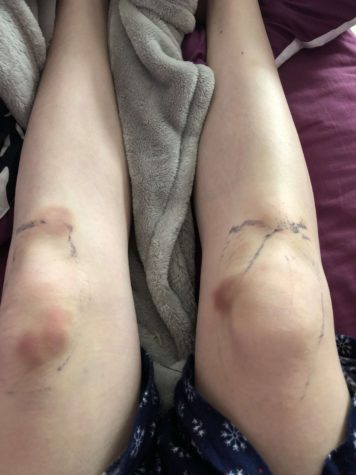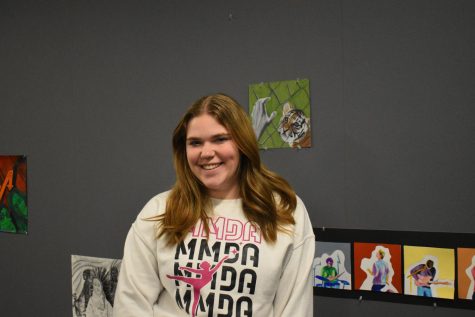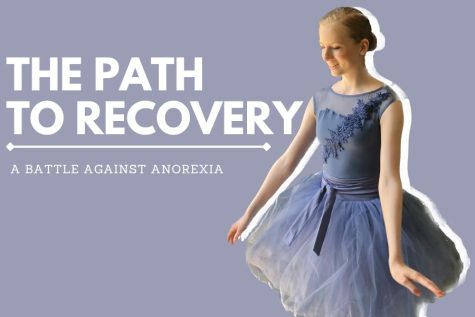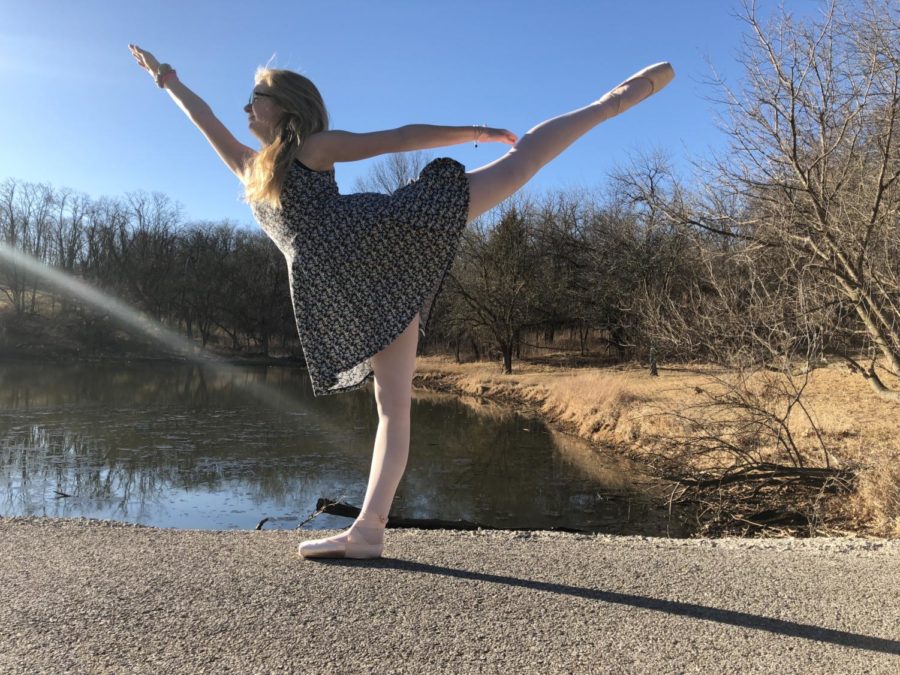Sophomore Maggie Lyerla dances through EDS
Maggie poses by holding her leg behind her in the arabesque position at Queeny Park. “I brought point shoes to the park to take pictures for our Instagrams,” Lyerla said. “Sometimes I do lyrical improv at home and I work on pointe alone because I have to keep up with my strength because my ankles are hypermobile.”
Passionate about dance, sophomore Maggie Lyerla has been twirling since the age of two. However, she faces a genetic disorder called Ehlers Danlos Syndrome (EDS), where joints are overly flexible, dislocate easily and that leads to bruised skin.
“My joints are more hypermobile than other people. My elbow goes back, my wrists go back really far and my knees [can go back too],” Lyerla said. “It can cause my joints to dislocate, like my shoulder–I can pop it in and out.”
Although EDS is commonly mistaken for being double jointed, Lyerla’s condition goes far beyond that.
“I was just randomly waking up covered in bruises–my arms would be [completely] bruised. My mom almost took me to the hospital because that’s sketchy,” Lyerla said. “Waking up covered in bruises is not a healthy thing.”
EDS runs in the Lyerla family; her triplet, sophomore Sissy Lyerla, was diagnosed with EDS through the Beighton scale hypermobility test which assesses the range of movement in joints, two years before Maggie.
“When I went [to the doctor], all they had to do was the Beighton scale, which is just like, ‘Can you do this?’ and ‘Is your skin stretchy?’ They were like, ‘Sissy has it? You have it. Congratulations!’”
Lyerla attends her dance studio, Krupinski Academy of Dance, around three times a week and dances despite her condition.
“I like going [to Krupinski] and not having to worry about school,” Lyerla said. “When I was younger I was really naturally flexible, so I stuck with it. I just liked it and kept going.”
When packing her dance bag, she makes sure to come prepared with more than just ballet shoes.
“I have to wear knee braces when I dance because my kneecaps can move around a lot, and my tendon yanks my kneecap up so it’s higher than its supposed to be. When I’m off stage I use rollers to loosen the tendons that pull on my knees to keep them from going out,” Lyerla said. “My pelvis also gets out of line a lot because of dancing and the turn-out; when you turn your legs outward.”
Lyerla’s experience at Krupinski has been largely positive thanks to her coach’s display of understanding.
“One of the teachers has [EDS] too, and all the Krupinskis’ are related in some way, so they all knew what it was already, and I didn’t have to explain it. Mark, the owner of the studio, is really understanding about it. He’ll let me sit if I need to, and he explains it to the new teachers and stuff. It’s nice.”
If Lyerla is not cautious, EDS can leave her exhausted.
“Especially for dance, I get tired really easily because I have to use my muscles more to hold my joints in place,” Lyerla said. “I have to make sure I ate enough and won’t be exhausted. I work on pointe alone because I have to keep up my strength because my ankles are hypermobile.”
Maggie was one of the 21 people chosen from her studio to represent Missouri at a Los Angeles dance convention.
“I went to Los Angeles for dance, and I didn’t have knee braces or anything yet because I was just starting physical therapy. They didn’t know if I had [EDS] badly or if it was mild,” Lyerla said. “[In Los Angeles], both my knees kept shifting around while I was dancing, so instead of doing a whole week of intensives, I only did two days of it.”

Remnants of Lyerla’s tape stick to her bruised legs as she snaps a photo of her battle scars after performing four times at Chaminade. “I took that picture to send to my friend from American Dance Troupe to gross them out,” Lyerla said. “We have a running joke of me being ‘broken.’”
When on stage, Lyerla does not wear her knee braces due to their distracting appearance.
“My chiropractor tapes my knees, that way, I don’t have black knee braces walking into a dance,” Lyerla said. “When I’m on stage I’m not really thinking about [the braces]. I’m just focused on dancing.”
Maggie’s rare condition has made her more attentive to her health in her daily life.
“I have to be a lot more conscious about what I do because a normal person would just be like ‘Oh, I can go to this thing and stand the whole time’,” Lyerla said. “I have to think about how long I will be able to be there. Will I have to bring knee braces? Do I need to do anything preventive before?”
Despite her condition, Maggie is passionate about dance.
“Sometimes it may be hard, but I’m thankful my studio understands and lets me sit when I need to,” Lyerla said. “When I feel like giving up, I know I’ll regret it. I dance because I love it and it’s fun to do.”


![“I'm excited for what the future holds. [Being a professional dancer] gives me a space where I can just be myself and I can transfer [my] emotions to my dance. My favorite [type of] dance is Jazz. It's really fun and there are a bunch of different styles within it. I can do a bunch of a bunch of tricks, [and] I like turns. I'm most happy [when I’m with] my dance friends because they just get me. We've grown up together, and they're really special to me. My biggest struggle is being a perfectionist, because with being a dancer [I] have to get everything right. [I have to have] the right counts, [and do] the tricks right, so [I] just have to be perfect [in] doing things. My favorite memory is probably [going to] nationals. We won the entire competition. We got first place, and it was really fun, seeing everyone in the audience tear up. We were all so happy, we just forgot about all of our worries.” - Poppi Wright, 11](https://pwestpathfinder.com/wp-content/uploads/2023/11/IMG_7178-600x400.jpg)
![“Even though I really love performing and practicing every day, my favorite part about the dance team has to be the people on the team and the bonds that I've made the past two years. That's really what's kept me coming back. I've made friendships on Longhorn Line that will last a long time and I have met my best friends through dance. This year, I'm taking harder classes than I did last year. So, my biggest fear going into sophomore year was having too much homework and having to either pull back on the amount of dance that I was doing on the dance team or quit dance altogether in order to get all my work done. Around this time last year, I dislocated my shoulder during a performance. It took me out of dance for a really long time while I tried to rehabilitate my shoulder. It was really hard for me because I couldn't move my arm at all. I pretty much lost any strength I had in my arm. I had to get it all back and it took a really long time. I had to work everyday to get my strength back. It was a struggle for me because I couldn't dance and I literally had to dance with one arm. A struggle for me right now is balancing everything that's going on in my life, like studio, Longhorn Line and homework. It’s hard because I try to make sure I get all my homework done, but also knowing all my routines and [being able to] go to practices and studio every night. I’m happiest at studio dance because that's where all my best friends are. When you go to the studio each night you can forget anything that happened during your day. It's kind of like a little escape from the rest of your life or whatever is happening at that moment.” - Lila Kayser, 10](https://pwestpathfinder.com/wp-content/uploads/2023/10/DSC_0002-600x400.jpg)

![Fully running through “Pippin” for the first time, sophomore Jack Mullen performs the opening number alongside his castmates to kick off tech week. Having been diagnosed with COVID-19 one week before the show, theater teacher and Director Amie Gossett relied on her students to step up to help the show run smoothly in her absence. “As a whole, this has been a very collaborative experience for all the kids. They’ve learned to take responsibility [while] pushing themselves to keep the show going. [They learned] to believe themselves in stepping outside of their comfort zone and to push for what they want,” Gossett said.](https://pwestpathfinder.com/wp-content/uploads/2023/03/DSC_0036-475x317.jpg)

![“[The happiest moment of my life was when] when I did my first dance solo for the first time, it was contemporary and to the French song, "Je te laisserai des mots" [by Patrick Watson]. I performed it last season, so March through May, and got 11th overall in one competition for it. [I also] got platinum and high gold at other competitions. I've been competing for six years, but dancing for 13 years. Dance is like therapy to me, I get to express myself, especially with styles like contemporary and hip hop,” - Sam Johnson, 10](https://pwestpathfinder.com/wp-content/uploads/2023/01/DSC_0001-1-475x317.jpg)

![Sophomore Lila Hartle and other Bollywood night participants mirror sophomore Triya Gudipati’s moves during the first dance class. Hartle liked seeing her friend teach a different dance style. “As someone learning [this style] for the first time, [Gudipati] made it easy and friendly to follow along,” Hartle said.](https://pwestpathfinder.com/wp-content/uploads/2022/11/DSC_0410-475x317.jpg)

Alina Dunder • Mar 9, 2018 at 7:09 pm
I loved this story. I heard about Maggie having this I think once or twice in class, but learning about it is truly amazing. This is really motivational and inspirational for anyone who suffers from something that can hold them back; especially physically. Go Maggie!!